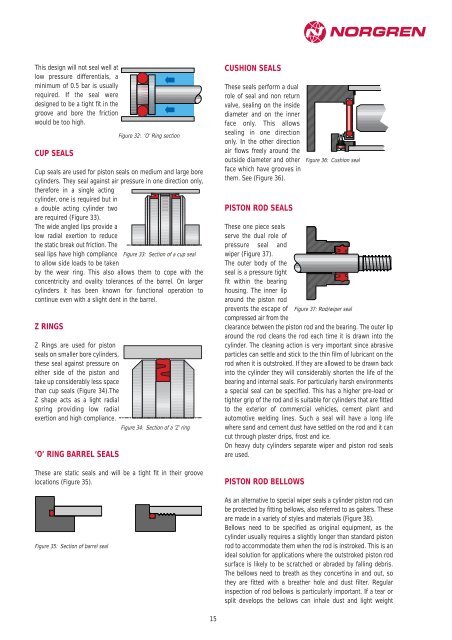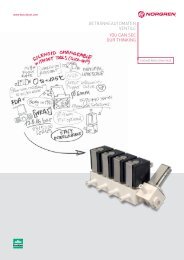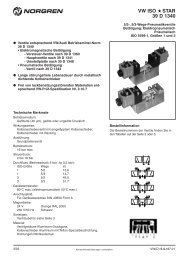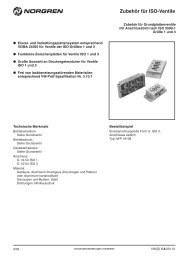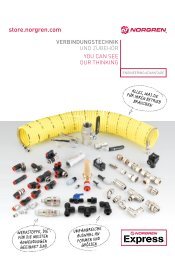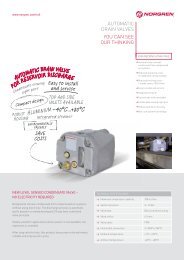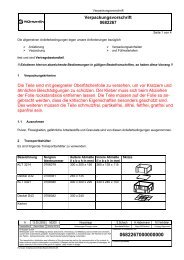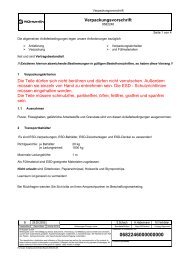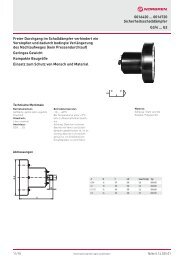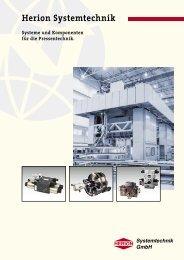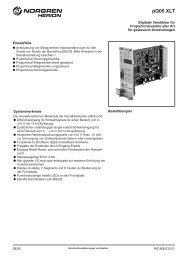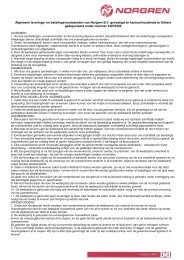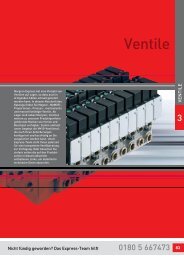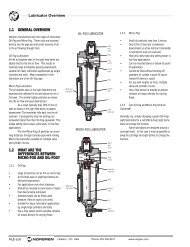Actuator Guide - Norgren Pneumatics. Motion Control Equipment ...
Actuator Guide - Norgren Pneumatics. Motion Control Equipment ...
Actuator Guide - Norgren Pneumatics. Motion Control Equipment ...
Create successful ePaper yourself
Turn your PDF publications into a flip-book with our unique Google optimized e-Paper software.
This design will not seal well at<br />
low pressure differentials, a<br />
minimum of 0.5 bar is usually<br />
required. If the seal were<br />
designed to be a tight fit in the<br />
groove and bore the friction<br />
would be too high.<br />
CUP SEALS<br />
Figure 32: ‘O’ Ring section<br />
Cup seals are used for piston seals on medium and large bore<br />
cylinders. They seal against air pressure in one direction only,<br />
therefore in a single acting<br />
cylinder, one is required but in<br />
a double acting cylinder two<br />
are required (Figure 33).<br />
The wide angled lips provide a<br />
low radial exertion to reduce<br />
the static break out friction. The<br />
seal lips have high compliance Figure 33: Section of a cup seal<br />
to allow side loads to be taken<br />
by the wear ring. This also allows them to cope with the<br />
concentricity and ovality tolerances of the barrel. On larger<br />
cylinders it has been known for functional operation to<br />
continue even with a slight dent in the barrel.<br />
Z RINGS<br />
Z Rings are used for piston<br />
seals on smaller bore cylinders,<br />
these seal against pressure on<br />
either side of the piston and<br />
take up considerably less space<br />
than cup seals (Figure 34).The<br />
Z shape acts as a light radial<br />
spring providing low radial<br />
exertion and high compliance.<br />
Figure 34: Section of a ‘Z’ ring<br />
‘O’ RING BARREL SEALS<br />
These are static seals and will be a tight fit in their groove<br />
locations (Figure 35).<br />
Figure 35: Section of barrel seal<br />
15<br />
CUSHION SEALS<br />
These seals perform a dual<br />
,, |<br />
role of seal and non return<br />
valve, sealing on the inside<br />
diameter and on the inner<br />
face only. This allows<br />
sealing in one direction<br />
z|,, yy {{ ,y{ {<br />
only. In the other direction<br />
air flows freely around the<br />
outside diameter and other Figure 36: Cushion seal<br />
face which have grooves in<br />
them. See (Figure 36).<br />
PISTON ROD SEALS<br />
,, yy zz<br />
These one piece seals<br />
serve the dual role of<br />
pressure seal and<br />
wiper (Figure 37).<br />
{{ || ,, yy zz<br />
The outer body of the<br />
seal is a pressure tight<br />
fit within the bearing<br />
housing. The inner lip<br />
around the piston rod<br />
{{ ||<br />
prevents the escape of Figure 37: Rod/wiper seal<br />
compressed air from the<br />
clearance between the piston rod and the bearing. The outer lip<br />
around the rod cleans the rod each time it is drawn into the<br />
cylinder. The cleaning action is very important since abrasive<br />
particles can settle and stick to the thin film of lubricant on the<br />
rod when it is outstroked. If they are allowed to be drawn back<br />
into the cylinder they will considerably shorten the life of the<br />
bearing and internal seals. For particularly harsh environments<br />
a special seal can be specified. This has a higher pre-load or<br />
tighter grip of the rod and is suitable for cylinders that are fitted<br />
to the exterior of commercial vehicles, cement plant and<br />
automotive welding lines. Such a seal will have a long life<br />
where sand and cement dust have settled on the rod and it can<br />
cut through plaster drips, frost and ice.<br />
On heavy duty cylinders separate wiper and piston rod seals<br />
are used.<br />
PISTON ROD BELLOWS<br />
yy z{{<br />
z|<br />
As an alternative to special wiper seals a cylinder piston rod can<br />
be protected by fitting bellows, also referred to as gaiters. These<br />
are made in a variety of styles and materials (Figure 38).<br />
Bellows need to be specified as original equipment, as the<br />
cylinder usually requires a slightly longer than standard piston<br />
rod to accommodate them when the rod is instroked. This is an<br />
ideal solution for applications where the outstroked piston rod<br />
surface is likely to be scratched or abraded by falling debris.<br />
The bellows need to breath as they concertina in and out, so<br />
they are fitted with a breather hole and dust filter. Regular<br />
inspection of rod bellows is particularly important. If a tear or<br />
split develops the bellows can inhale dust and light weight


